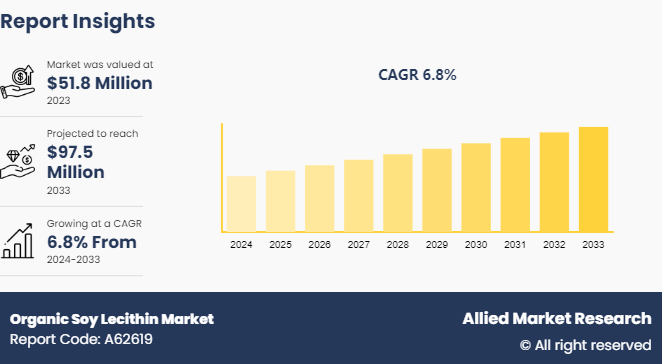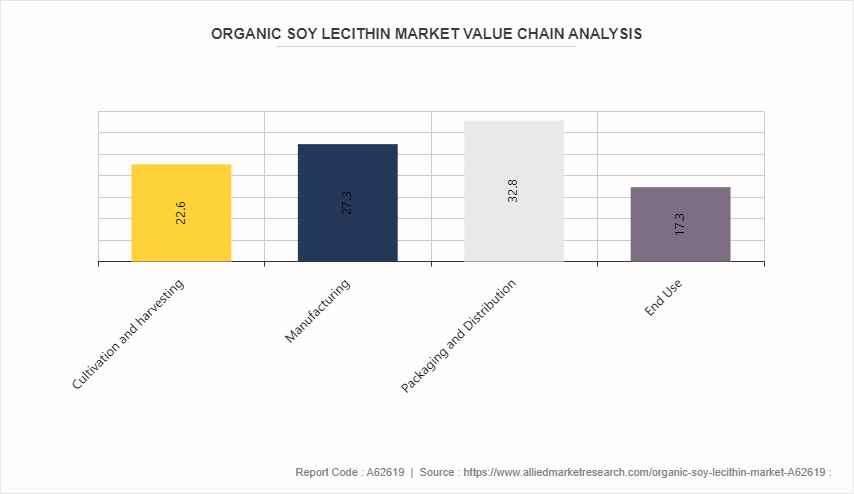Organic Soy Lecithin Market Research, 2033
The global organic soy lecithin market size was valued at $51.8 million in 2023, and is projected to reach $97.5 Million by 2033, growing at a CAGR of 6.8% from 2024 to 2033.

Market Introduction and Definition
The organic soy lecithin industry is a rapidly expanding sector within the organic food industry, characterized by the production and distribution of lecithin derived from organically grown soybeans. Organic soy lecithin is a natural emulsifier derived from organic soybeans, commonly used in food production and various industrial applications. It consists of phospholipids, including phosphatidylcholine, phosphatidylethanolamine, and phosphatidylinositol, which aid in mixing oil and water-based substances, enhancing texture and stability in food products. The organic variant promotes sustainability and minimizes environmental impact, as it is cultivated without synthetic pesticides or fertilizers. Organic soy lecithin market share is expected to increase as it serves as a versatile ingredient in the food industry, found in chocolates, baked goods, salad dressings, and more, providing a clean label option for consumers seeking organic and natural alternatives in their diet and lifestyle.
Key Takeaways
The organic soy lecithin market study covers 20 countries. The research includes a segment analysis of each country in terms of value for the projected period.
More than 1, 500 product literatures, industry releases, annual reports, and other such documents of major energy storage system industry participants along with authentic industry journals, trade associations' releases, and government websites have been reviewed for generating high-value industry insights.
The study integrated high-quality data, professional opinions and analysis, and critical independent perspectives. The research approach is intended to provide a balanced view of global markets and to assist stakeholders in making educated decisions in order to achieve their most ambitious growth objectives.
Key Market Dynamics
The rise in consumer preference for non-GMO and organic products has become a significant driver for the surge in the organic soy lecithin market demand. As consumers increasingly prioritize health and wellness, there is a growing awareness of the potential health risks associated with genetically modified organisms (GMOs) and the use of synthetic chemicals in agriculture. Organic soy lecithin, derived from non-GMO soybeans cultivated without synthetic pesticides or fertilizers, aligns with these preferences, offering a cleaner and more natural alternative for food, beverage, and personal care product formulations. As a result, the organic soy lecithin market has experienced rapid growth as manufacturers respond to evolving consumer preferences for healthier, more sustainable, and ethically produced ingredients.
However, concerns regarding allergenic potential and soy-related sensitivities serve as a restraint on the organic soy lecithin market growth. While soy lecithin is generally recognized as safe by regulatory authorities, individuals with soy allergies or sensitivities may experience adverse reactions, including skin rashes, digestive issues, or respiratory problems. Some consumers actively avoid products containing soy-derived ingredients, including organic soy lecithin, leading to a reduced market demand during the Organic Soy Lecithin Market Forecast.
Moreover, the development of novel applications in the pharmaceutical and healthcare sectors presents lucrative opportunities for the organic soy lecithin market. The natural emulsifying and stabilizing properties of soy lecithin is increasingly being explored for various pharmaceutical formulations, including drug delivery systems, liposomal formulations, and nutritional supplements. The compatibility of soy lecithin with lipid-based formulations and ability to improve bioavailability make it a convenient ingredient for enhancing the efficacy and performance of pharmaceutical products. As consumers become more aware about the ingredients intake, there is an increase in preference for organic alternatives, which drives pharmaceutical companies to explore organic soy lecithin as a viable ingredient for meeting consumer expectations for safety, efficacy, and sustainability in healthcare products in the coming years.
Value Chain of Global Organic Soy Lecithin Market
The value chain of organic soy lecithin begins with soybean cultivation, ensuring compliance with organic standards. Harvested soybeans undergo processing to extract soybean oil, which is then refined and purified to produce organic soy lecithin. The refined product is packaged and distributed to manufacturers, who formulate it into various end products like baked goods, cosmetics, and pharmaceuticals. Throughout the chain, quality control measures are implemented to maintain product integrity. Marketing efforts emphasize the organic certification and functional properties of soy lecithin. Ultimately, consumers purchase products containing organic soy lecithin, driven by health consciousness and sustainability concerns.

Market Segmentation
The Organic Soy Lecithin Market Analysis is done on the basis of type, form, application, and region. On the basis of type, the market is bifurcated into refined and unrefined. As per form, the market is divided into liquid, powder, and granular. On the basis of application, the market is segregated into food and beverages, animal feed, pharmaceuticals, personal care, industrial applications, and others. Region wise, the market is analyzed across North America, Europe, Asia-Pacific, and LAMEA.
Regional/Country Market Outlook
According to the Organic Trade Association (OTA) , organic food sales in the U.S. in 2022 crossed $60 billion for the first time, marking another significant milestone for the resilient organic sector. Total organic sales, which include organic non-food products, reached a record $67.6 billion. The surge in organic food sales, as revealed by the 2023 Organic Industry Survey, is anticipated to drive the growth of the organic soy lecithin industry. With consumers increasingly opting for organic products, there is a growing demand for organic soy lecithin, a common ingredient in various food and industrial applications. As a result, the organic food trend offers an opportunity for producers and suppliers to expand their offerings and drive further growth in the organic soy lecithin market size.
The retail sales of organic products in Europe reached a total value of $58.3 billion in 2022, where $49.4 billion belong to the European Union (EU) . Germany emerged as the largest market, with the sales of $16.8 billion. Globally, the EU held the position of the second-largest single market for organic products after the U.S., which reported sales of $65.4 billion. Moreover, in 2022, consumers in Europe spent an average of $75 on organic food per person. In 2022, Swiss and Danish consumers led in spending the most on organic food, with $488 and $409 per capita, respectively. Thus, the rapid growth of the organic products market in Europe, including increased consumer spending on organic food, is expected to positively impact the organic soy lecithin market by creating greater demand for organic ingredients across various food and feed applications.
In the year 2022-23, India cultivated approximately 2.9 million metric tons of certified organic products, including a diverse range of food items such as oil seeds, fibers, cereals, pulses, spices, among others. Thus, the expansion in organic agriculture trend is likely to stimulate the market growth of organic soy lecithin, as consumers increasingly seek organic alternatives across various food and non-food sectors.
Industry Trends:
The increase in preference for natural ingredients has led to a growing utilization of lecithin across various sectors, including bakery, confectionery, dairy, and meat products. The demand of soy lecithin in bakery products is significant, given its vital role in enhancing moisture retention and ensuring the even blending of flour with other ingredients during baking procedures. Typically, lecithin is incorporated into bread formulations at 0.2% and layer cakes at 0.5% - 1.5% based on flour weight. The surge in bakery product production and exports, especially in Asian countries, further boosts the demand for lecithin, thereby benefiting the organic soy lecithin market.
Based on data from the UN Comtrade, India's exports of bread, pastry, cakes, and other bakery products amounted to $407.6 million in 2022, which has crossed the exports valued of 2021 at $346.8 million. Thus, the increased sales of bakery products in Asia-Pacific countries including India are expected to boost the organic soy lecithin market across the region.
Competitive Landscape
The major players operating in the organic soy lecithin market include Cargill, Incorporated, Archer Daniels Midland Company, NOW Foods, Lipoid GmbH, Lecico GmbH, Bunge Limited, Thew, Arnott & Co Ltd, GIIAVA Pvt Ltd, American Lecithin Company, Clarkson Grain Company Inc.
Other players in organic soy lecithin market share includes Natural Sourcing LLC, SunOpta Inc., Solgar Inc., Jedwards International, Inc., VAV Life Sciences Pvt Ltd and so on.
Recent Key Strategies and Developments
In September 2021, AAK completed the acquisition of BIC Ingredients, the lecithin division of BIC International Holdings. Specializing in sunflower, soy, rapeseed, and other organic lecithins, the company's acquisition was aimed at enhancing the product portfolio in specialty lecithin and providing dependable solutions in food, pharmaceuticals, cosmetics, and other industries.
In September 2019, Praan Naturals introduced organic soy lecithin powder and liquid tailored for use in the cosmetics and personal care industry to broaden the product range and extend applications within cosmetics, including skincare, nail care, hair care, among others.
In February 2019, Lasenor Emul, S.L. and Simmons Grain Co. announced the joint venture under the name Lasenor USA LLC to produce a full set of organic soya lecithin products suitable for different food and feed applications.
Key Sources Referred
Organic Trade Association (OTA)
The Soil Association
FiBL (Research Institute of Organic Agriculture)
The Rodale Institute
The Organic Center
Euromonitor International
USDA Economic Research Service (ERS)
Food and Agriculture Organization of the United Nations (FAO)
National Restaurant Association (NRA)
National Retail Federation
Agricultural & Processed Food Products Export Development Authority (APEDA)
India Brand Equity Foundation
Key Benefits For Stakeholders
- This report provides a quantitative analysis of the market segments, current trends, estimations, and dynamics of the market analysis to identify the prevailing organic soy lecithin market opportunities.
- The market research is offered along with information related to key drivers, restraints, and opportunities.
- Porter's five forces analysis highlights the potency of buyers and suppliers to enable stakeholders make profit-oriented business decisions and strengthen their supplier-buyer network.
- In-depth analysis of the organic soy lecithin market segmentation assists to determine the prevailing market opportunities.
- Major countries in each region are mapped according to their revenue contribution to the global market.
- Market player positioning facilitates benchmarking and provides a clear understanding of the present position of the market players.
- The report includes the analysis of the regional as well as global organic soy lecithin market trends, key players, market segments, application areas, and market growth strategies.
Organic Soy Lecithin Market Report Highlights
| Aspects | Details |
| Market Size By 2033 | USD 97.5 Million |
| Growth Rate | CAGR of 6.8% |
| Forecast period | 2024 - 2033 |
| Report Pages | 398 |
| By Type |
|
| By Form |
|
| By Application |
|
| By Region |
|
| Key Market Players | Lipoid GmbH, Archer Daniels Midland Company, GIIAVA Pvt Ltd, Cargill Incorporated, NOW Foods, Bunge Limited., Clarkson Grain Company Inc., Arnott & Co Ltd, American Lecithin Company, LLC, Thew, Lecico GmbH |
Organic soy lecithin market was valued at $51.8 million in 2023, and is estimated to reach $97.5 billion by 2033.
The global organic soy lecithin market is projected to grow at a compound annual growth rate of 6.8% from 2024 to 2033 reach $97.5 million by 2033.
The major players operating in the organic soy lecithin market include Cargill, Incorporated, Archer Daniels Midland Company, NOW Foods, Lipoid GmbH, Lecico GmbH, Bunge Limited, Thew, Arnott & Co Ltd, GIIAVA Pvt Ltd, American Lecithin Company, Clarkson Grain Company Inc.
North America region was the highest revenue contributor to the market and is expected to grow at a significant CAGR during the forecast period.
Rising demand for non-GMO and clean-label products, increased use in plant-based and vegan foods, growing applications in the pharmaceutical and cosmetic industries, focus on sustainable and traceable sourcing, and expansion in functional foods and dietary supplements.
Loading Table Of Content...



